Exploring the depths: Advances in drilling and foundation technology
05 June 2023
Electrification is happening across construction and the drilling and foundations sector is no exception, but the journey has only just begun, reports Catrin Jones.
The construction industry is building bolder, taller, and more ingeniously than ever before. The key to a building’s success largely comes down to how strong the foundations and groundwork are. Drilling and foundations equipment needs to be capable of handling unique challenges, such as drilling through hard rock or operating in extreme weather conditions.
Eva-Leena Varpe, product manager of surface drilling at Sandvik, knows the importance of reliable equipment and says that Sandvik puts their drills through rigorous testing before they are sent to market.
“Both factory and site testing are a standard part of our product development projects. We have great facilities at the factory where we are testing all our products on a component and product level,” she says.
“In our test mine, we have facilities to do component testing, for example, duration tests. We also use third-party testing if we are missing tools or testing methods, or if a third-party test report is required.”
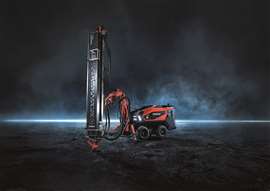 "Electrification is one option and one way to proceed towards zero emission" (Photo: Sandvik)
"Electrification is one option and one way to proceed towards zero emission" (Photo: Sandvik)
Varpe adds that site testing is done in cooperation with users on their sites. Sandvik carefully selects testing sites that present challenging environments for the rig. The testing phase lasts several months and encompasses all seasons and weather conditions throughout the year.
“In addition to development project-related tests, we constantly follow up on our rigs on site and collect feedback. All our rigs are test drilled with real rock conditions at the Tampere factory in Finland before delivering to the user.”
Reducing environmental impact when drilling
Drilling can significantly impact the environment and surrounding urban landscape – both contractors and equipment manufacturers are increasingly looking at ways to reduce this.
“Sandvik follows closely the development and implementation of environmental requirements and assess our compliance with these. Sandvik has, as a company, committed to the Science Based Targets initiative, which provides a clearly defined pathway to reduce greenhouse gas emissions,” adds Varpe.
“This helps us to create targets that are ambitious and in-line with the latest science and to plan what happens in the future. We see that sustainability is a wide concept and there are many ways to affect and minimise environmental impacts.”
For Sandvik, the biggest and the most obvious environmental factor to consider is the CO2 emissions that are emitted during the operation of the machine. Varpe says that one of the most efficient ways to reduce CO2 emissions is the development of alternative energy sources.
“Electrification is one option and one way to proceed towards zero emission. According to our vision, Sandvik Surface division will offer a complete range of electrified drilling solutions in all hole sizes and drilling applications by 2030.”
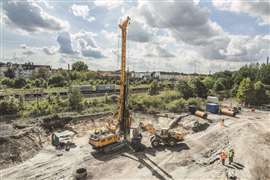 The path to electric equipment will take some time (Photo: Bauer)
The path to electric equipment will take some time (Photo: Bauer)
Electric solutions in drilling and foundation equipment
Liebherr is also hard at work developing electric solutions – the company’s LRH 100.1 piling rig is one of the latest models in the electrically driven unplugged series.
Fitted with a hammer H 6 of the latest generation, the company says that the rig has found its first jobsite in Sweden. The company, Hercules Grundläggning AB, is using this model to drive approximately 300 concrete piles into the ground.
Liebherr says that the LRH 100.1 unplugged has a large working range with a radius of up to 8.7m, which is advantageous to users as the machine does not have to be constantly moved. The design of the leader enables inclinations of up to 18° in all directions with the possibility to raise or lower the leader by 4m – thereby increasing the flexibility of the machine.
For the piling work, Hercules Grundläggning AB has equipped the LRH 100.1 unplugged with a Liebherr hammer type H 6. The modular hammer can be used with drop weights of between 3,000kg and 6,000kg, depending on requirements.
At a jobsite in Karlstad, Sweden, piles are driven into the soil with a 5,000kg weight from a drop height of 40cm.
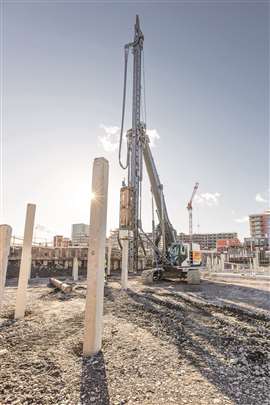 The Liebherr LRH 100.1 unplugged (Photo: Liebherr)
The Liebherr LRH 100.1 unplugged (Photo: Liebherr)
“Here, we are using a free-fall hammer, i.e., it is not accelerated. We only compensate for the power loss with the cylinders. This has the advantage, especially when driving concrete piles, that these are not damaged so much as when using accelerated hammers,” explains Liebherr’s product manager, Michael Rajek.
Adapting to conditions
Depending on the length of the pile, between 800 and 1,500 strokes of the hammer are necessary for each one. Rajek says, “The control system is designed in such a way that the operator can now adjust the pile-driving energy and the number of strokes independently of each other, and thus ideally adapt to the conditions.”
The hammer used by Hercules Grundläggning AB belongs to Liebherr’s latest generation in the series. “We have more or less changed the whole architecture of the existing H 6 hammer. The new steel construction is specially designed for stiffness, longevity and for reliability,” adds Rajek.
Due to the redesign of the hammer, the noise emission is said to have been reduced by 35%.
Liebherr says that the electro-hydraulic drive of the LRH 100.1 unplugged has the same performance specifications as the conventional version. Both are operated in the same way, which can be convenient for machine operators if they have to switch between machines.
As the machine has an electric drive it emits zero emissions and is extremely quiet, making it suitable for noise-sensitive regions or urban worksites. The battery is charged using a conventional jobsite electric supply but operation can continue as normal while charging.
 Marcus Leü, global product manager at Epiroc (Photo: Epiroc)
Marcus Leü, global product manager at Epiroc (Photo: Epiroc)
Another company developing its products for the future is Germany-based Bauer Maschinen Group – the company produces a wide range of foundation engineering equipment. Dr. Ruediger Kaub, CEO of Bauer Maschinen believes that electric power is key to the future of construction equipment but says that it requires more government incentives to encourage the industry to make the switch.
“Our customers are really serious about sustainability. There’s no doubt. But they have to calculate their projects, and they have to run their projects profitably. And a machine like that [electric] costs substantially more and it’s not that easy to operate on a normal construction site, because it’s still relatively new,” says Kaub.
“To handle a cable like that on a normal construction site comes with additional efforts, and hence additional costs. There are companies taking sustainability to the next step, but they have to see benefits.”
Impact of regulations on construction projects
Marcus Leü, global product manager at Epiroc, agrees that regulations will be a key driver behind the push for electric solutions. “We see very clearly that to enter cities today we need to reduce the noise and reduce the dust,” he says.
“There are some cities where you’re not allowed to enter without noise reduction kits. We have developed new noise reduction kits that have lighter weight and a stronger design to fulfil the requirements in these cities.”
Epiroc has recently launched the SmartROC T25 R, a radio-remote rig built on a new platform. The machine will initially be launched for the Swedish and the Norwegian market but there are plans to roll out it globally later in the year, with the North American market expected to drive a large proportion of the sales.
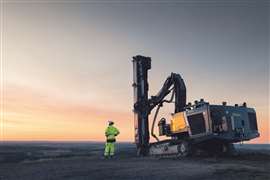 Epiroc’s SmartROC T25 R (Photo: Epiroc)
Epiroc’s SmartROC T25 R (Photo: Epiroc)
Leü tells International Construction that there were four main values the company had in mind when designing the rig: terrainability and stability; versatility; digitisation and environmental.
He says that the new model has up to three times more coverage area than the previous model and is also more versatile, enabling a contractor to switch from trench drilling to foundation blasting or road cuttings.
New technology has also been integrated into the machine. “The machine is remote controlled; it gives you full functionality of the rigs. You have a monitoring screen on board. You’re free to operate and monitor everything from the remote.”
This technology is not new, but the amount of data that the operator can monitor is much more than before with Lei saying they have “levelled up the information and the control.”
Looking to the future of drilling and foundations
The increasing digitisation of drilling and foundation equipment as well as technology such as remote controls, alongside machines that emit less emissions, will only increase in the future.
One way to encourage more electric machines is to develop subsidies to reduce the costs for the companies who choose to have at least a percentage of construction equipment electrified. Even with this, the change will take time – it will not happen overnight.
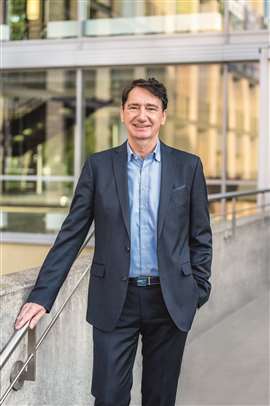 Dr Kaub, CEO of Bauer Maschinen, believes that electric power is key to the future of construction (Photo: Bauer Maschinen)
Dr Kaub, CEO of Bauer Maschinen, believes that electric power is key to the future of construction (Photo: Bauer Maschinen)
“The industry will take time to really step in more and more into electrification. But it will come, whether it is battery, direct electric drive, fuel cell powered by hydrogen. We will see all sorts of combinations, we will definitely see that transformation, but it will take years,” says Kaub. He adds that machines are now ‘data tools’.
“My big vision is, at the end of the day, our machines have to work completely remote controlled, mostly automated,” he says. “We are working on more and more of these assistance systems…our vision is that we take the operator away and maybe he sits in an office, and he has a big screen watching three machines. We still need to have the human being watching.”
Demand for automation
When it comes to the direction of travel regarding technology, Leü says, “The trend is clear; the request for more drilling data is growing.”
He adds that in the future, “We will see a growing demand for automation. We already see it on the mine side. The construction side is years behind because it’s more complicated, more machines, more people. But for sure there will be autonomous rigs in the future. Five years, 10 years, 20 years, I don’t know. But we are ready.”
While both sustainability and the electrification of construction equipment are hot topics in the industry, it will take time to fully develop the solutions needed on the construction site of the future. What there is little doubt of though, is that the changes are already happening.
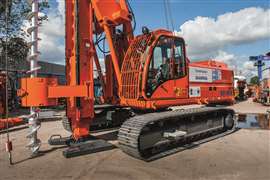
The piling rig installed four 30-metre-deep piles during a trial carried out in collaboration with Skanska’s piling and ground engineering business, Cementation Skanska, hydrogen fuel company ULEMco and the Business Research Establishment.
The project, funded through the BEIS Phase 1 Red Diesel Replacement competition, employs a dual-fuel system that enables mixing diesel and biofuels (HVO) with hydrogen. This replaces fuel with hydrogen, resulting in lower CO2 emissions and fuel use reduction.
HS2 reports a 36% reduction in traditional fuel use due to the hydrogen dual fuel piling rig. In addition to this, 19 HS2 sites have become entirely diesel-free.
Andrea Davidson, head of environmental sciences for HS2, said, “HS2 is continuing to drive a positive change in the construction sector and is providing an important environment to develop the real-world use of hydrogen energy technology.
“The development of dual-fuel systems that can be used to adapt existing equipment so it can run off cleaner, low carbon energy sources, could be a game changer across the construction sector.”
STAY CONNECTED



Receive the information you need when you need it through our world-leading magazines, newsletters and daily briefings.
CONNECT WITH THE TEAM








